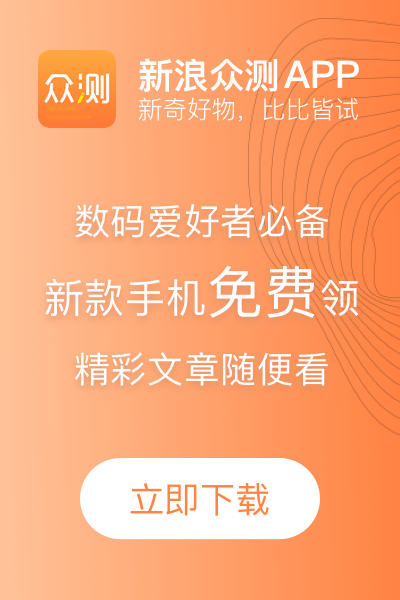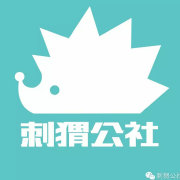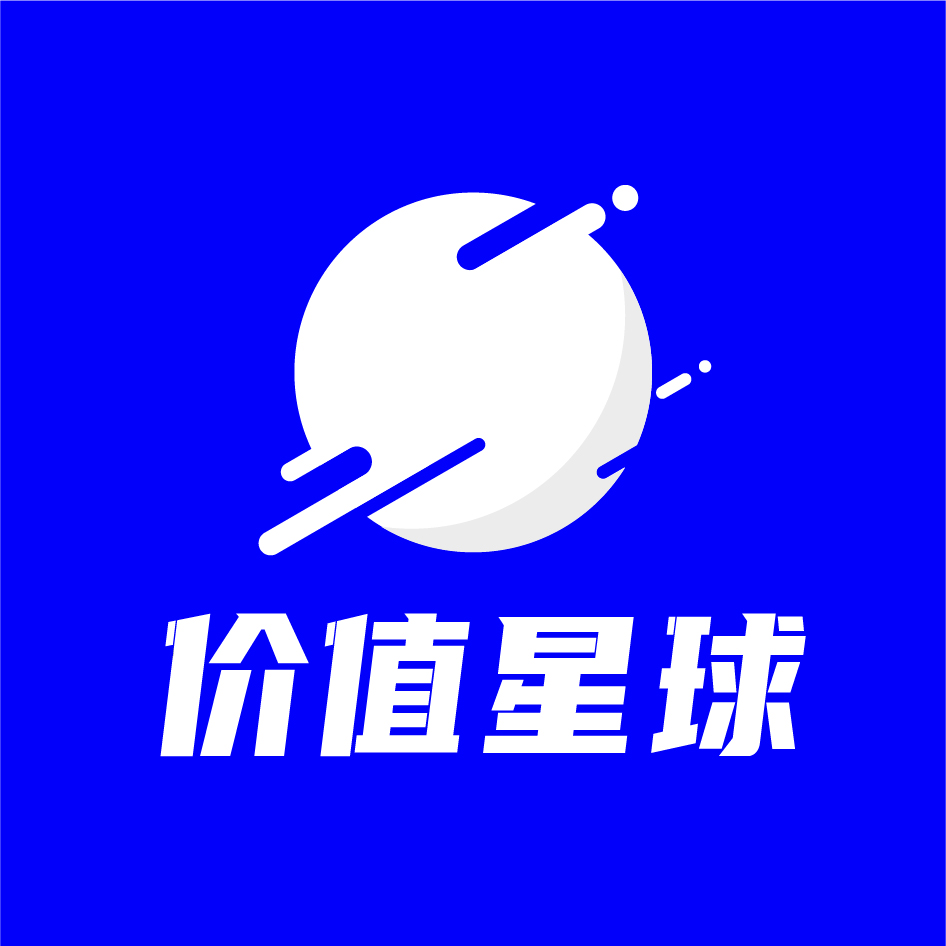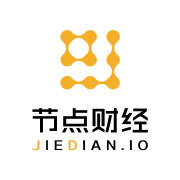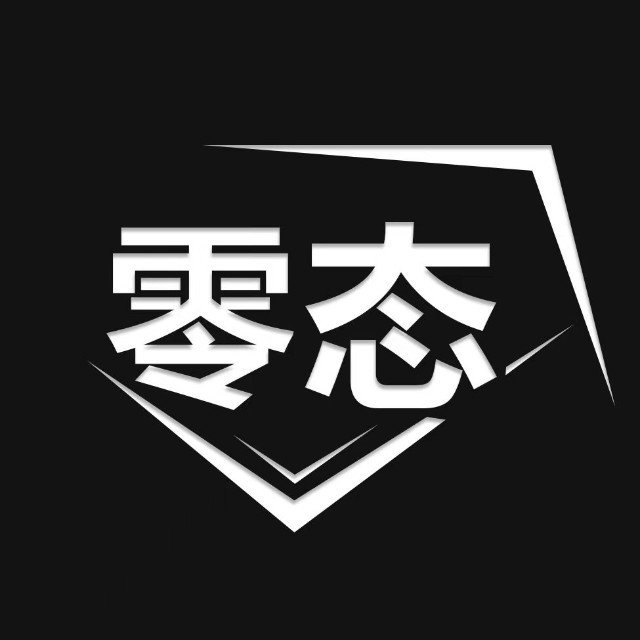Welcome to follow the WeChat subscription account of "Sina Technology": techsina
Article | Zhang Zhan
Editor | Shi Can
If you want to buy a bottle of Coke, you should also be able to buy Dr. Pepper in American supermarkets, in addition to Coca Cola and Pepsi. Some fanatical fans call it "real American Coke"; In German supermarkets, you can also buy the 90 year old Afri Cola.
Unfortunately, In most areas of China, you can only buy Coca Cola and Pepsi Cola in supermarkets, convenience stores and mom and wife stores. Only in certain regional markets or special channels can you see such national brands as Laoshan Coke, Special Coke and Tianfu Coke.
If the time goes back to the 1980s, China's coke market will be a different picture:
Coca Cola returned to China after exiting the Chinese market in 1949, and its first bottling plant in New China was completed and put into operation in 1981; Laoshan Coke, which was born in 1953, has set up 47 packaging plants in 21 provinces and cities in China and in Shandong Province; Tianfu Cola, Asian Cola and Special Cola were all introduced in this period.
Such a scene has long since ceased to exist. Today, more than 90% of China's carbonated beverage market share is shared by Coca Cola and Pepsi Cola. As for the reason, some people describe it as "Two Joys drown seven armies" - in the 1990s, seven major soda plants in China signed joint venture agreements with Coca Cola and Pepsi Cola, with the attitude of learning management and technology from the West, and finally "lost their own things".
Perhaps not reconciled to the current market situation, in 2002, after difficult negotiations with PepsiCo, Asian soda was "redeemed"; In 2004, Laoshan Coke reappeared in the market; In 2008, Tianfu Cola began to claim the ownership of formula and production process from Pepsi; Since 2022, new actions in the Coke market have continued.
In the 2022 CCTV Spring Festival Gala of the Year of the Tiger, Wahaha's special cola replaces the "regular guest" Huiyuan juice on the Spring Festival Gala and appears in the audience of the 2022 CCTV Spring Festival Gala, as if to declare its sovereignty on this traditional festival.
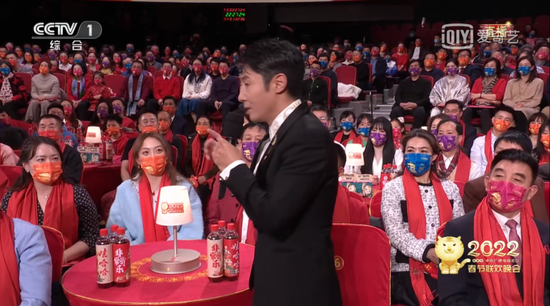 Very cool in the audience of the Spring Festival Gala | Screenshot from CCTV Spring Festival Gala
Very cool in the audience of the Spring Festival Gala | Screenshot from CCTV Spring Festival Gala On July 22, Yuanqi Forest announced in Beijing that it would soon launch Coke flavored soda bubble water - it was reported that compared with the popular sugar free cola on the market, the product replaced the controversial artificial sugar substitute aspartame with natural sugar substitute erythritol, and did not contain chemical preservatives such as sodium benzoate and potassium sorbate, and completely removed chemical synthetic additives such as phosphoric acid.
Under the tide of the rise of domestic products, how far are Chinese people from a bottle of their own cola?
Between advance and retreat, China's cola turns upside down
The simple desire to own a cola belonging to the Chinese began to be put into practice 69 years ago.
In 1953, organized by the Ministry of Light Industry, Shandong State run Qingdao Soda Factory bravely took the task of "creating colas belonging to the working people of China". Based on Laoshan mineral water, Qingdao Soda Plant matches it with Chinese herbal ingredients such as black jujube, angelica dahurica, amomum villosum, galangal and cloves to mix the taste of cola. Finally, Qingdao Soda Plant creates the first cola of Chinese people - Laoshan Coke.
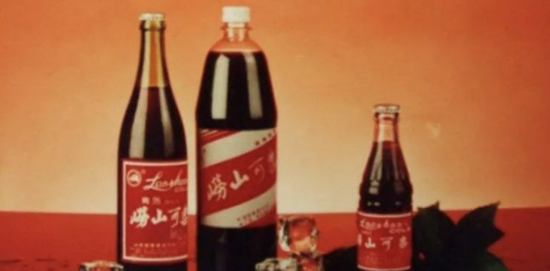 Laoshan Coke | Tuyuan Qingdao Urban Archives Forum
Laoshan Coke | Tuyuan Qingdao Urban Archives Forum After 30 years of development, Laoshan Coke has become the local symbol of Qingdao with its distinctive packaging and unique taste of traditional Chinese medicine. At the same time, Laoshan Coke has also become a well-known brand throughout the country.
According to the report of Shanghai Wenhui Daily in 1981, Laoshan Coke was deeply loved by consumers at that time, and its sales volume took the lead nationwide, with an annual output of 2 million dozen; Even after drinking Laoshan Coke, some American businessmen could not help sighing that the cola made from Chinese medicine has a unique taste, which is beyond the reach of foreign drinks.
After 1985, Laoshan Coke set up 47 sub packaging plants with an annual production capacity of 80 million tons, accounting for 80% of the local market in Qingdao and 20% of the national market.
At that time, on the Chinese soda map, although it was not said that "a city has a coke", "a city has a soda" was true ——In addition to Laoshan Coke in Shandong Province in East China and Zhengguanghe in Shanghai, there are Dabili in Harbin and Bawang Temple in Shenyang in Northeast China, Shanhaiguan in Tianjin and the Arctic Ocean in Beijing in North China, Bingfeng in Xi'an and Haibi in Luoyang in Central China, Emei Snow in Chengdu and Tianfu Coke in Chongqing in Southwest China, and Asian Sand Show in Guangzhou in South China.
The turning point of the story took place in 1994, a year destined to be written in the history of Chinese carbonated drinks.
In that year, facing the impact of Coca Cola and Pepsi Cola, in order to make progress by retreating, under the arrangement of China Light Industry Association, seven major soda plants in China signed joint venture agreements with the two major manufacturers: Bawangsi soda, Shanhaiguan soda and Wuhan No.2 Factory soda are jointly invested with Coca Cola, while Laoshan Coke, Asia Sashi Coke, Tianfu Coke and Arctic Ocean Coke are jointly invested with Pepsi.
Xing Huiming, secretary of the Party Committee of Beijing First Light Chemical Industry Group, a company affiliated to Arctic Ocean, said that at that time, everyone felt that "the moon in foreign countries was rounder than that in China", so they had to learn management and technology from the West. However, what everyone did not expect was that in the end, they "lost their own things".
After the joint venture, "Liangle" strives to improve its control over the joint venture brand, intervene or even dominate the management and operation of the joint venture brand, and occupy the living space of domestic soda brands by virtue of a high proportion of shares or by increasing the share capital——
-
After being acquired by Coca Cola, Laoshan Coke was soon marginalized, and its channels were squeezed, thus forced to stop production;
-
After the joint venture with PepsiCo, Tianfu Cola was frozen, and the running water production in 1994 was only 2% of the original;
-
Similar to Tianfu Cola, Asia Cola and Pepsi will be frozen after their joint venture.
In addition to these joint ventures, other brands are not so lucky:
-
Zhengguanghe Accepted the Coca Cola OEM, so that they abandoned their martial arts, and their Happy Coke could not be produced again;
-
The famous Fenhuang Coke, which came out in 1998, almost stopped production in 2001 because of many problems such as tight channels and funds;
-
Wahaha's Coke Similarly, after a period of scenery, for some reason, it gradually declined.
History has proved that the so-called "retreat for progress" strategy has become a pure regression. Before that, "Two Joys" had already launched an "attack" at the market level.
In 1983, Beijing Coca Cola Company planned the first sales promotion in China's contemporary market - in major stores, consumers can get a pair of chopsticks or a balloon if they buy a bottle of Coke;
In 1986, in order to improve its market reputation, Coca Cola paid 200000 yuan for the opportunity to broadcast advertisements on CCTV, which was almost the total profit of Coca Cola in China in the first year.
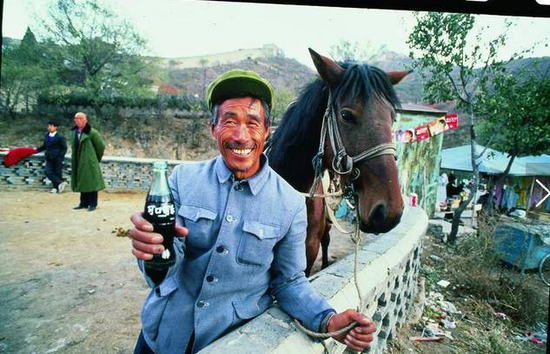 Chinese farmers are drinking Coca Cola | Tuyuan "Legend of Supermarket"
Chinese farmers are drinking Coca Cola | Tuyuan "Legend of Supermarket" Between advance and retreat, China's Coke pattern has turned upside down.
Rush in, who can set off the "cola storm" again?
From a purely commercial perspective, Coke is really not a good category - "Two Joys" is strong, the market space is narrow, and breaking through is close to finding the moon in water.
Even so, there are still many cola brands determined to return, such as Tianfu Cola.
On January 6, 2016, after recovering the trademark through judicial channels, Tianfu Cola held a brand comeback ceremony in Chongqing. This is a ceremony full of sadness:
On both sides of the venue were 20 meter long ink-jet boards with the background color of the Holocaust Memorial in gray. More than 20 black and white photos recording the past glory and decline of Tianfu Cola were printed on them. The song My Chinese Heart was also played in the venue.
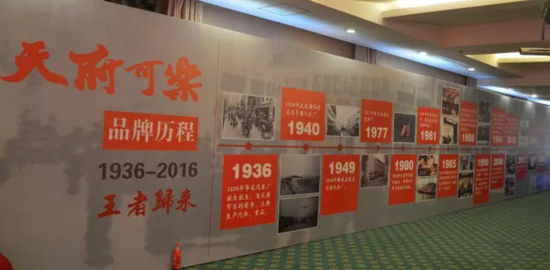 The scene of Tianfu Cola's comeback ceremony | source of pictures: "food maker"
The scene of Tianfu Cola's comeback ceremony | source of pictures: "food maker" Unlike the newly launched products or brands, the old Coke has a strong sense of history and nationality. Few people doubt the significance of the comeback from the commercial value. People care more about the spiritual atmosphere represented by the comeback - firmly continue the historical context, face challenges without fear, and believe in the power of national brands.
Or from the perspective of consumers, people are looking forward to such a scene: when a consumer stands in front of the freezer in a convenience store and wants to choose a bottle of cola flavored beverage, there are various choices on the shelf. If he wants to drink a foreign brand, he will drink a foreign brand, and if he wants to drink a domestic brand, he will drink a domestic brand.
But looking at the brand apart from the product itself is not quite in line with the essence of business, and it is easy to fall into the "feelings trap". An excellent positive case is that Sanya is a century old carbonated beverage brand owned by Asahi of Japan, which achieved an annual sales growth of more than 100% in 2020; In addition to the brand advantages accumulated over a century, Sanya Cola can not add any preservatives to its products, so why do Chinese consumers have no similar choice of cola?
In this way, our desire for local colas not only contains some national feelings, but also contains our expectations for innovative products - there are nearly 300 kinds of colas in the world, so can China's local colas solve the new problems faced by consumers?
As we all know, although the "Fat House Happy Water" cola tastes good, even sugar free cola is hardly a healthy drink:
On the one hand, the phosphoric acid added in cola is harmful to human body - some studies have shown that excessive intake of phosphate is harmful to human bones, cardio cerebral vessels, and 700 mg of phosphorus per day will affect bone health, 1.8 g of phosphate per day will lead to dental caries, and the commonly used phosphate additives in beverages are easier to be absorbed by human body than those contained in food itself;
On the other hand, chemical preservatives commonly used in traditional colas, such as sodium benzoate and potassium sorbate, can also cause harm to human health, "persuading" a large number of parties.
Three years ago, through communication with users, Yuanqi Forest found that while sugar free drinks gradually became the mainstream of China's beverage market, consumers still had various complaints about sugar free cola.
Therefore, in order to solve these user pain points, some young product managers of Yuanqi Forest tried to set up a project within the company to develop a new Coke. The project team was named "YYDS", which is the network term "eternal god".
Members of the YYDS project team made a lot of research and preparation at the initial stage of project approval. They collected nearly 40 kinds of colas from all over the world, tasted and analyzed taste differences one by one, and formulated more than 1000 kinds of formulation schemes. They drank 5-8 liters of formulation every day. Finally, they found a formulation solution that can simulate the acid feeling of phosphate without damaging bones.
In terms of preservatives, Deer Horn, the co-founder of Yuanqi Forest, said that in October last year, chemical preservatives such as sodium benzoate and potassium sorbate were no longer added to the whole line of bubble aquatic products of Yuanqi Forest, which benefited from the introduction of the world's leading sterile production line of carbonic acid by Yuanqi Forest.
In addition, more natural ingredients are also used as far as possible in the cola flavor gas bubble water in Yuanqi Forest to improve the taste and health. For example, the natural sugar substitute erythritol extracted from corn and other crops is used to replace the artificial sugar substitute aspartame commonly used in traditional cola, and the natural citric acid is used to replace the currently commonly used sodium citrate. Yuanqi Forest also selects the more expensive Paraguayan tea extract to replace the artificial caffeine of traditional cola.
Finally, Yuanqi Forest developed a new formula of "Yuanqi Coke". It is reported that this product will be sold online and enter some offline channels as soon as August, and there is no plan to launch a large-scale market in the short term.
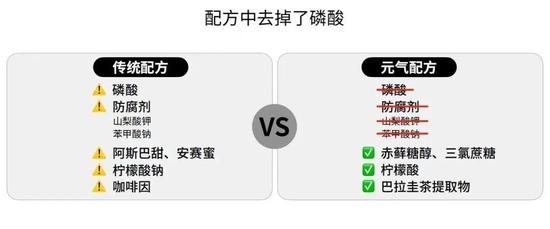 Formula of "Vital Coke" | interviewees from Tuyuan
Formula of "Vital Coke" | interviewees from Tuyuan Bamboo sticks and sandals are lighter than horses. Who is afraid?
In fact, when the "Vital Coke" project was first proposed, the internal opposition was very loud, even almost one-sided. "At that time, many colleagues were worried that if we tried to make cola flavored drinks, it would irritate the big cola factory. Because our size is equivalent to a small finger compared with that of international giants, it is easy to be killed by a slap. ”Deer horn.
Indeed, Coca Cola and Pepsi Cola have occupied most of the offline channels in China; And when it comes to Coke, I'm afraid people can only remember these two brands. It is almost impossible to make a cola under the eyes of "Two Joys".
But does this mean that making a new Coke is meaningless?
Deer Horn said: "Tang Binsen, the founder of Yuanqi Forest, became the most firm supporter of this project. He told us young people at that time that since there are so many cola brands in the world with the demand of users, why can Yuanqi Forest not try? How about the loser adding a new Yuanqi Forest in the history of cola products in the world? I still remember his original words—— 'Since users have demands, it is better to walk around gracefully than to wriggle.'. ”
This product attitude implies Yuanqi Forest's "conservative" sales expectation for this product. Antler explained that the quality of this product will ultimately be decided by young users and the market, and the success or failure will not be considered in the short term. "Even if it doesn't work out, it's valuable to help users eliminate a wrong answer."
Throughout the world, There are not many cola products that can compete with the "Two Delights" in the local market, but the few of them have one common feature, that is, they have long rooted in the local market and are deeply bound with the local culture.
Dr. Pepper was born in 1885, one year older than Coca Cola. The reason why some people say that "only Dr. Pepper can represent the real American cola" is not only because of the taste of its American characteristics, but also from the perspective of cultural integration.
As a native brand in Texas, Dr. Pepper is an American national drink with "good roots and red shoots" - like a tough and affectionate Texas cowboy, Dr. Pepper conveys an incomparable American romantic feelings; It exudes wild and unrestrained rock characteristics, and was once described as the "source of inspiration" by rock artists.
According to the data released by the American media Beverage Digest, in 2015, Dr. Pepper's market share in the United States was 17.3%; In some areas of Texas, the sales of Dr. Pepper even exceeded that of Coca Cola.
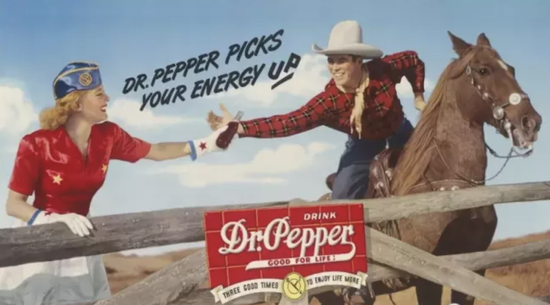 Doctor Pepper Advertisement | Tuyuan Doctor Pepper Official Website
Doctor Pepper Advertisement | Tuyuan Doctor Pepper Official Website Founded in 1931, Germany's Afri Cola is one of the largest beverage brands in Germany. In terms of raw materials, Afri Cola uses water from the Alps; In appearance, since 1962, the bottles it uses are considered to be the coolest in the soft drink industry.
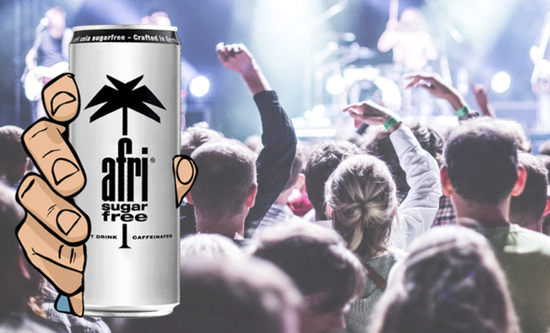 Germany afri Cola | Screenshot from Tmall
Germany afri Cola | Screenshot from Tmall In addition to these old beverage brands, there is a special existence - Thailand EST Coke.
The owner of EST brand is Thailand sermsuk company, which has always been the manufacturer and distributor of Pepsi Cola. However, on April 1, 2012, sermsuk cancelled the production and sales agreement with PepsiCo. PepsiCo built its own factory, while sermsuk created its own EST cola brand to seize the Thai cola market.
With its profound production capacity, channel capacity and logistics capacity, the brand has occupied 12% of the market share of carbonated drinks in Thailand in less than two years. But clearly, the success of EST Cola is difficult to replicate.
These so-called "success stories" actually prove the difficulty of new products breaking through the tight encirclement. But this may not be important. As Tang Binsen said, why can't we "go for a walk"?
Six years ago, the Tianfu Coke comeback ceremony was printed with the words: "There was a glorious history, and a new chapter is about to begin." We want to say that the "new chapter" does not necessarily need to be brilliant, and the "unfolding" itself is full of meaning.
(Statement: This article only represents the author's view, not Sina.com's position.)










